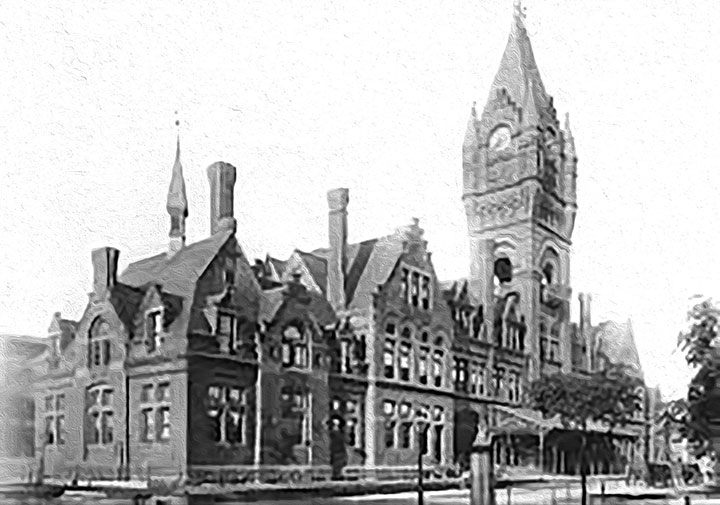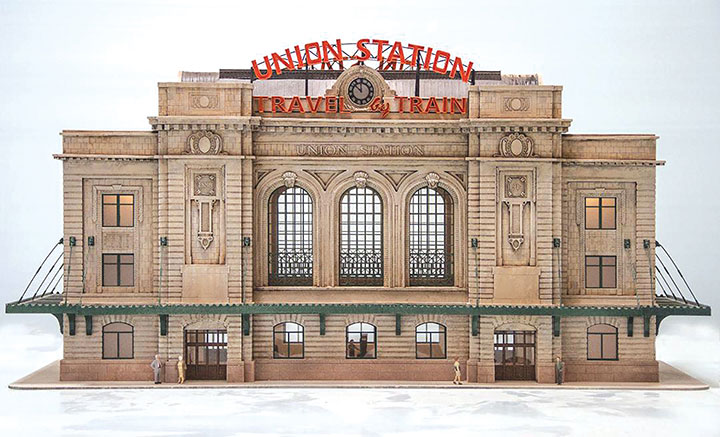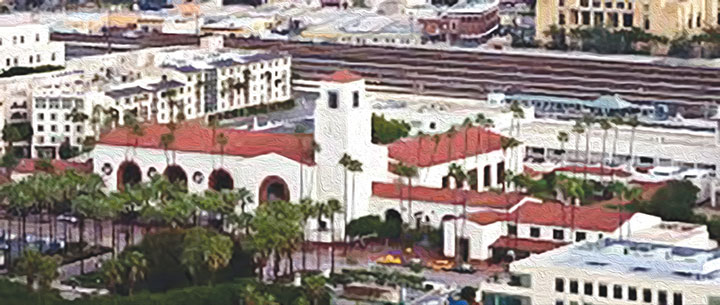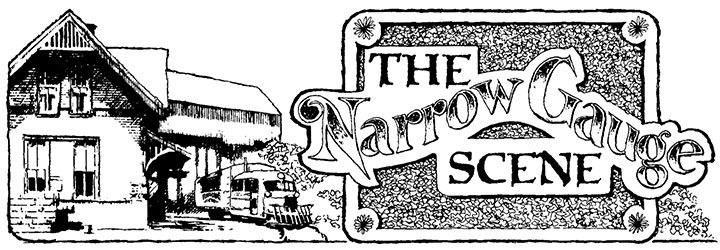Given our collective age, I use the word “terminal” with some care. I refer to the railroad definition for the end point on a rail line, not a stage in life. By definition, all rail lines have terminal points, even narrow gauge lines. And surprisingly, some of these points were not minor towns in the middle of nowhere. For example, both the Colorado & Southern and Rio Grande narrow gauge lines once began/ended in Denver, hardly a remote municipality. Indeed, the C&S narrow gauge lines operated from Denver until the late 1930s. The D&RGW’s narrow gauge lines from Denver were standard-gauged decades earlier, but originally used Denver as the starting point. There was once narrow gauge in Boston and in the San Francisco Bay Area. And even Los Angeles had a narrow gauge transit line. Therefore, the quaint notion of narrow gauge as a rural or frontier phenomenon is somewhat misleading. While true in large part, the busy cityscape was not unknown to the narrow gauge world. So, if you, like me, enjoy urban modeling, the concept of a narrow gauge line in a city setting is not anachronistic.
Secondly, and obviously, if you are modeling a specific narrow gauge line, it would have to be one of the few that did operate in an urban setting and in an era when that occurred. For Colorado, you could model the late 19th century with the D&RG operating into Denver, or the mid-1930s for the C&S narrow gauge operating into Denver’s Union Station. But if you model the East Broad Top for example, neither Orbisonia nor Mt. Union, Pennsylvania, would qualify as a major urban setting. If you decide to free-lance, the world is your oyster as they say. You can add that city/urban station to your narrow gauge line if you wish.
Thirdly, a major urban station would probably be a “Union Station,” i.e., one serving more than a single railroad. Again, this was not uncommon with narrow gauge lines. Even the Rio Grande Southern, as isolated as it was, ended at two “Union Stations” in Ridgway and Durango, each sharing station space with the D&RGW. The C&S narrow gauge did so in Denver’s Union Station. Therefore, both the concept of a narrow gauge line operating out of an urban area and utilizing a Union Station are supported by prototypes. Of course, the advantage of including a Union Station serving more than one railroad is the opportunity to include a standard gauge line for contrast and interchange.
My long-planned free-lance HO/HOn3 layout will feature such an urban Union Station serving both narrow and standard gauge lines. I love urban modeling and hope to put to use my fifty years of built structures to create a major urban center. Over the years through numerous review kits and assembly for my own use, I have accumulated numerous city-style buildings with more kits awaiting their turn. I suspect I am not alone in my interest in the urban scene. I have visited so many wonderful free-lance narrow gauge layouts over the years and have been inspired by a number of excellent big city representations. In addition, I have seen how effective narrow gauge/standard gauge interchange can be. Shinohara’s 3-rail HO/HOn3 track and turnouts opened possibilities for such operations and adding that feature to a big city scene is irresistible. Such a large city, served by both standard and narrow gauge lines, would justify a major urban Union Station. And as with Denver, odds are the narrow gauge line would terminate there.
Now, most Union Stations are massive municipal structures generally of two architectural styles. One was Beaux Arts, defined by Wikipedia as the academic style taught at the Ecole des Beaux Arts in Paris from approximately the 1830s to the early 1900s. It had a strong influence upon architecture in the U.S., especially large municipal buildings such as libraries, government buildings and train stations well into the mid-20th century. Beaux Arts stations generally feature stone construction with large windows, columns, arched and pedimented doors and decorative features such as statues or bas relief classical elements. A variation of this style is referred to as Romanesque, where arches are most prominent. Examples of such architecture can be found in the Denver Union Station or Grand Central Station in New York City. The Grand Central is a “terminal style” station as passenger trains literally dead-end there, whereas Denver is a through station with trains passing through in each direction.

-Photo courtesy of www.OldMilwaukee.net
The second common style of station architecture is the Victorian style, which covers a wide variety of materials including wood or brick. This style is characteristically replete with fancy gingerbread or brick decorative features. Major brick stations were common with notable examples being the Point of Rocks station in Maryland or the Everett Street Station in Milwaukee, Wisconsin. These stations could be constructed of stone, but more likely were made of brick, often with details of wood or stone. They could be very elaborate, appearing indistinguishable from European buildings, with steep gables and slate roofs. I am no expert on architecture, but suspect the majority of urban terminal stations would fall somewhere within these two categories. One notable exception? The Los Angeles Union Passenger Terminal (LAUPT), made from stucco in a quasi-Spanish style so common in Southern California.

-Courtesy of www.TrainDame.com.
From Chicago to Cincinnati to Portland, most major urban centers featured an impressive station serving multiple railroads. So, if you conclude like me that an impressive narrow gauge urban terminal station would be desirable, what station to choose? This is a matter of personal preference for the free-lancer. You could scratchbuild one of your own design or copy a prototype. You could also use a commercial kit. Possibilities include Walthers Cornerstone series Union Station in HO or N and the Bachmann/Plasticville’s Union Station in either HO or S/O. Custom Model Railroads also offers an impressive acrylic kit for a major urban station in HO. These represent the Beaux Arts or Romanesque style. Walthers also offers other Beaux Arts urban kits that could be combined or kit bashed with their Union Station for an even more impressive station. Walthers even once produced a model of the LAUPT.

-Courtesy of Wikipedia.
Victorian brick/stone urban depot kits are also plentiful and some of my favorites include SS Ltd.’s aptly named “Victorian Station” and Oregon Rail Supply’s “Menomonee Falls” station (out of production). Walthers also sells the very impressive, limited run Milwaukee Road “Everett Street Station with Train Shed” in HO. I have always admired this ornate and massive kit. At two feet long in HO with an impressively tall clock tower, Walthers’ distinctive Victorian style model with accompanying four-foot-long train shed makes a statement as a big city terminal. Now technically, this station is not a terminal design, i.e., with trains ending in a stub end yard. Rather it is a through station with trains passing through from either direction. So do not think New York City’s Grand Central Station, but rather Denver Union Station. From that perspective, it is better suited for model railroad purposes.
I decided that the Walthers kit would serve my purpose of having a centerpiece impressive urban station. However, as I am sure many of you would agree, it is always a problem to use a very distinctive kit easily recognizable on a layout. Not only is it recognizable as a kit, but the Milwaukee Road prototype limits its use even on a free-lance road. Having visited many model railroads over the years, I am always mildly bothered by recognizing kits, or anachronistic buildings that seem out of place. My good friend, Don Meeker, scratchbuilt a beautiful rendition of Denver’s Union Station for his HO layout. His free-lance road was set in Colorado and although he was not modeling Denver, the station looked entirely at home in his free-lance big city setting. However, were he modeling Pennsylvania, that same station would look out of place. I realize however that custom building or scratchbuilding everything is not practical, especially a major terminal station. So, the question becomes how to modify an otherwise recognizable kit so as to make it both plausible and disguise its origins.
In my case, the question was how to modify the Walthers Everett Street kit to disguise its heritage, at least to the extent practical, while retaining all of its architectural charm. That will be the subject of my next column. Understand that in so doing, I do not suggest you necessarily follow my lead but consider the possibilities of modifying any of the many commercial kits to make your own version of a major urban narrow gauge terminal station. It is also my hope that you will consider the advantages of incorporating an urban scene into your narrow gauge world. So, until next time, write, if the mood strikes.
